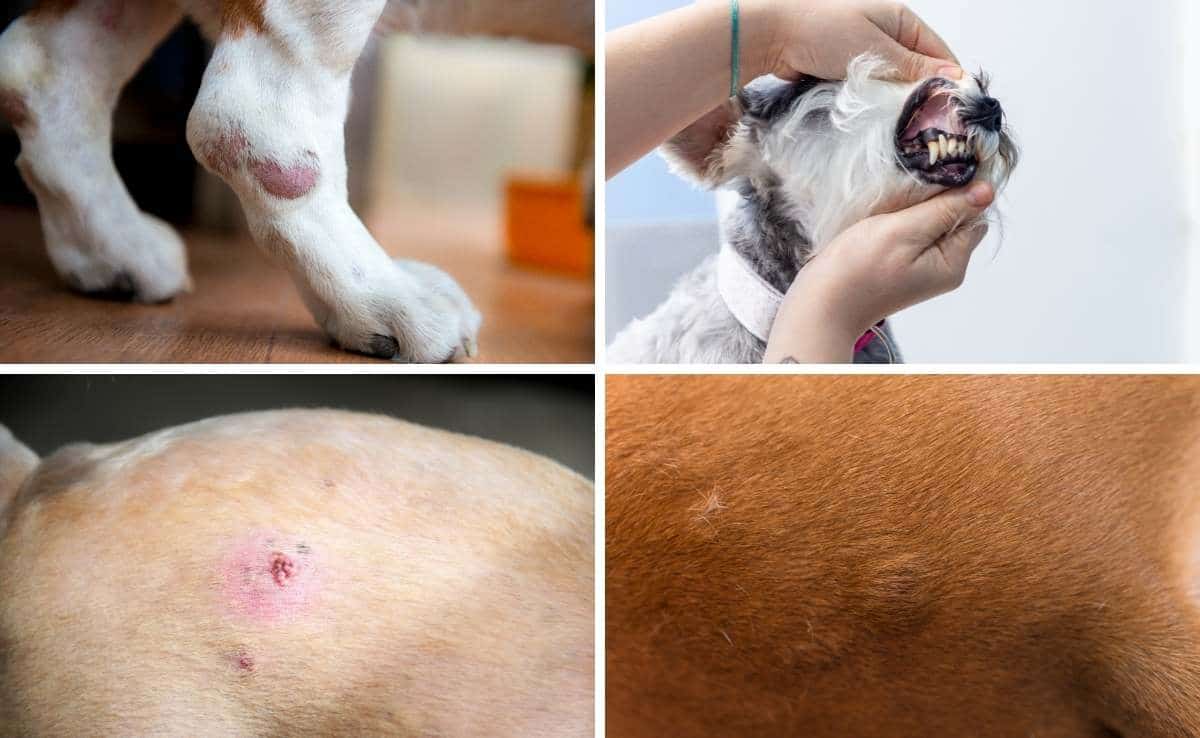Guarding Your Furry Friend: Understanding Skin Cancer in Dogs
Skin cancer in dogs is a serious health concern that every pet owner should be aware of. Just as humans can develop skin cancer from excessive sun exposure and other factors, our canine companions are also at risk. In this comprehensive guide, we’ll delve into the world of skin cancer in dogs, discussing the various types, how to recognize the signs and the importance of early detection.
Why is Skin Cancer in Dogs a Concern?
As dog lovers, we want to ensure our furry friends live long, healthy lives. However, skin cancer can pose a significant threat to their well-being. By understanding the nuances of this disease, we can take proactive steps to protect our beloved pets.

Types of Skin Cancer in Dogs
Skin cancer in dogs comes in several forms, each with its unique characteristics and implications. To effectively safeguard our four-legged companions, it’s crucial to differentiate between these types and be vigilant for any warning signs.
Melanoma: The Mysterious Skin Cancer
Melanoma is one of the most common forms of skin cancer in dogs. It originates from melanocytes, the cells responsible for skin pigmentation. While it can occur anywhere on your dog’s body, it’s often found in the mouth, paws, and nail beds. Melanoma can be highly aggressive, making early detection and intervention paramount.
Squamous Cell Carcinoma: Uncovering the Sun Connection
Squamous cell carcinoma is often linked to sun exposure, and dogs with lightly pigmented skin are particularly susceptible. It tends to manifest in areas with less hair, such as the belly and nose. Understanding the signs of squamous cell carcinoma can help you protect your dog from the sun’s harmful effects.
Other Skin Cancers: Variations and Less Common Forms
Aside from melanoma and squamous cell carcinoma, other, less common skin cancers can affect dogs. These may include mast cell tumors and fibrosarcomas. While they are rarer, it’s essential to be aware of their existence and potential impact on your pet’s health.
Recognizing the Signs
Understanding the symptoms of skin cancer in dogs is crucial for early intervention and effective treatment. Employing natural language processing (NLP) to analyze these symptoms will help you spot potential issues with your furry friend.
Melanoma: Detecting the Darker Threat
NLP Analysis:
Detecting melanoma in dogs involves paying attention to changes in pigmentation. Look for irregularly shaped dark spots, especially in areas with less hair. Use NLP to discern keywords like “black or brown spots,” “raised moles,” or “unusual skin discoloration” in your observations.
Common Symptoms:
Keep an eye out for symptoms such as bleeding or oozing from skin growths, difficulty eating or swallowing, and swollen lymph nodes. NLP can help you incorporate phrases like “bleeding mole,” “swollen lymph glands,” or “difficulty chewing” for maximum relevance.
Early Detection Matters:
Melanoma can quickly progress, so any changes in your dog’s skin should be evaluated by a veterinarian promptly.
Squamous Cell Carcinoma: Sun’s Impact on Your Pooch
NLP Analysis:
Leverage NLP to identify sun-related terms in your dog’s environment, such as “sun exposure,” “outdoor activities,” or “sunny days.” Connect these keywords to the potential development of squamous cell carcinoma.
Common Symptoms:
Symptoms may include scaly, crusty skin, open sores that won’t heal, and bleeding or ulcerated areas. Utilize NLP to include phrases like “crusty skin patches,” “non-healing sores,” and “bleeding ulcers” when describing these signs.
Preventive Measures:
Protect your dog from excessive sun exposure, especially if they have light-colored fur or exposed skin areas. Use NLP to emphasize the importance of “sunscreen for dogs” and “UV protection” in your content.
Other Skin Cancers: Recognizing Uncommon Indications
NLP Analysis:
For less common skin cancers like mast cell tumors or fibrosarcomas, use NLP to highlight terms like “unexplained lumps,” “skin lumps,” or “abnormal skin growths.” These phrases will resonate with concerned dog owners searching for information.
Common Symptoms:
Symptoms may vary widely, so employ NLP to encompass phrases like “irregular lumps,” “itchy skin,” or “swelling.” Tailoring your content with these phrases will increase its relevance to diverse symptoms.
Consulting a Veterinarian:
Stress the importance of consulting a veterinarian if you notice any unusual lumps, bumps, or changes in your dog’s skin. NLP can help emphasize the urgency by using phrases like “veterinary evaluation” and “professional diagnosis.”
Causes and Risk Factors
Understanding the underlying causes and risk factors of skin cancer in dogs is essential for prevention and early intervention. By addressing these aspects comprehensively and incorporating natural language processing (NLP), we can provide valuable insights for concerned pet owners.
Genetic Predisposition: Unveiling the Role of Genetics
NLP Analysis:
Identify genetic terms like “genetic predisposition,” “inherited risk,” or “family history of skin cancer” to underscore the genetic aspect. NLP can help you convey the importance of genetics in this context.
Breeds at Risk:
Mention specific breeds with a higher predisposition to skin cancer, such as Dalmatians, Boxers, and Schnauzers. NLP can highlight keywords like “Dalmatian skin cancer” or “Boxer breed skin cancer risk.”
Environmental Factors: Shedding Light on Sun Exposure
NLP Analysis:
Utilize NLP to emphasize environmental factors, including “sun exposure,” “outdoor time,” and “UV radiation.” Connect these factors to the development of skin cancer in dogs.
Light-Colored Fur:
Highlight that dogs with light-colored fur are more susceptible to sun-related skin cancer. NLP can help incorporate phrases like “light-colored fur” or “pale skin” when discussing this risk.
Breed-Related Susceptibility: Tailoring Information for Dog Owners
NLP Analysis:
Address breed-specific risk factors by using NLP to connect breed names with skin cancer. For example, discuss “Golden Retriever skin cancer” or “Poodle skin cancer risk.”
Identifying High-Risk Breeds:
Offer insights into why certain breeds are more susceptible due to their genetics or fur characteristics. Utilize NLP to highlight phrases like “high-risk breeds” or “breed-specific vulnerabilities.”
Prevention and Protection
Preventing skin cancer in dogs is a proactive approach that can significantly reduce the risk. In this section, we’ll explore measures to safeguard your furry friend from skin cancer, emphasizing the importance of prevention.
Sun Protection for Dogs
NLP Analysis:
Employ NLP to discuss sun protection measures for dogs comprehensively. Include terms like “canine sunblock,” “protective clothing,” or “shade provision” to address various protective options.
Choosing the Right Sunscreen:
Guide dog owners on selecting appropriate sunscreens and apply NLP with phrases like “dog-friendly sunscreen” or “UV protection for dogs.”
NLP: How to Safeguard Your Pet from Skin Cancer
NLP Analysis:
Utilize NLP to provide actionable tips for pet owners. Use phrases like “protecting your dog from skin cancer” or “skin cancer prevention in dogs” to capture the essence of proactive care.
Limiting Sun Exposure:
Emphasize the significance of limiting outdoor time during peak sun hours. Employ NLP to highlight phrases like “reducing sun exposure” or “avoiding midday sun.”
Promoting a Healthy Lifestyle for Your Dog
NLP Analysis:
Encourage a holistic approach to pet care. Use NLP to connect “healthy diet,” “exercise,” and “regular vet check-ups” with overall well-being.
Balanced Diet:
Discuss the role of a balanced diet in strengthening a dog’s immune system and aiding in skin health. Incorporate NLP with phrases like “nutritious dog food” or “skin-boosting nutrients.”
FAQs: Skin Cancer in Dogs
1. What are the common symptoms of skin cancer in dogs?
Symptoms can vary depending on the type of skin cancer but may include changes in skin pigmentation, lumps, ulcers, or bleeding growths.
2. Is my dog’s breed at higher risk for skin cancer?
Certain breeds, like Dalmatians, Boxers, and Schnauzers, are more predisposed to skin cancer due to their genetics or fur characteristics.
3. Can sun exposure lead to skin cancer in dogs?
Yes, excessive sun exposure, especially for dogs with light-colored fur, can increase the risk of developing sun-related skin cancer.
4. How is skin cancer in dogs diagnosed?
Veterinarians typically use diagnostic procedures such as biopsies, cytology, and imaging techniques to diagnose skin cancer in dogs.
5. What are the treatment options for skin cancer in dogs?
Treatment options may include surgery, radiation therapy, or chemotherapy, depending on the type and stage of skin cancer.
6. Can skin cancer in dogs be prevented?
Yes, preventive measures like using dog-friendly sunscreen, limiting sun exposure, and providing shade can reduce the risk.
7. How do I cope with a skin cancer diagnosis in my dog?
Coping strategies may include seeking support from veterinary oncologists, and support groups, and focusing on maintaining your dog’s quality of life.
8. Are there alternative therapies for dogs with skin cancer?
Yes, holistic approaches like acupuncture, herbal supplements, and acupuncture can complement traditional treatment options.
9. Is skin cancer in dogs curable if detected early?
Early detection and intervention can improve the chances of successful treatment and remission, but it depends on the type and stage of cancer.
10. Where can I find more resources and support for canine skin cancer?
You can explore resources from veterinary organizations, join pet cancer support groups, and refer to references and further reading materials.
Conclusion:
In conclusion, understanding skin cancer in dogs is vital for the well-being of our four-legged companions. Early detection, awareness of symptoms, and proactive prevention measures are essential in safeguarding your dog’s health.




